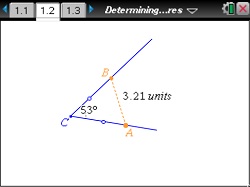Determining Angle Measure

Determining Angle Measure
Determine the measure of an angle and if larger angles have longer "sides."
- Students will recognize that the measure of an angle is independent of the distance between any two points on the rays that form the angle and of the length of the representation of the rays.
- Students will relate the measure of an angle to the fraction of a turn in a complete circle.
- Angle
- Ray
- Circle
- Radius
- Degree
- Arc
This lesson involves angle measures formed by two rays and fractions of a circle. As a result students will:
- Move points on rays that form an angle and note that the angle measure remains constant as the distance between two points on the rays changes.
- Extend the representation of the rays so that they appear to be longer and again note that the angle measure is independent of the length of the representation of the sides. The emphasis is on helping students understand that the measure of an angle is determined by the rotation of a side of the angle and not on the linear distance between the two sides of the angle.
- Move points onto designated spots along one of the angle’s rays to create circles with different radii. They will observe that the arc is the same fraction of a circle no matter how long the radius of the circle is.
- Describe the measure of the angle in degrees given the fraction of a complete turn.
Vernier EasyData,Vernier EasyLink and Vernier EasyTemp are registered trademarks of Vernier Science Education.

